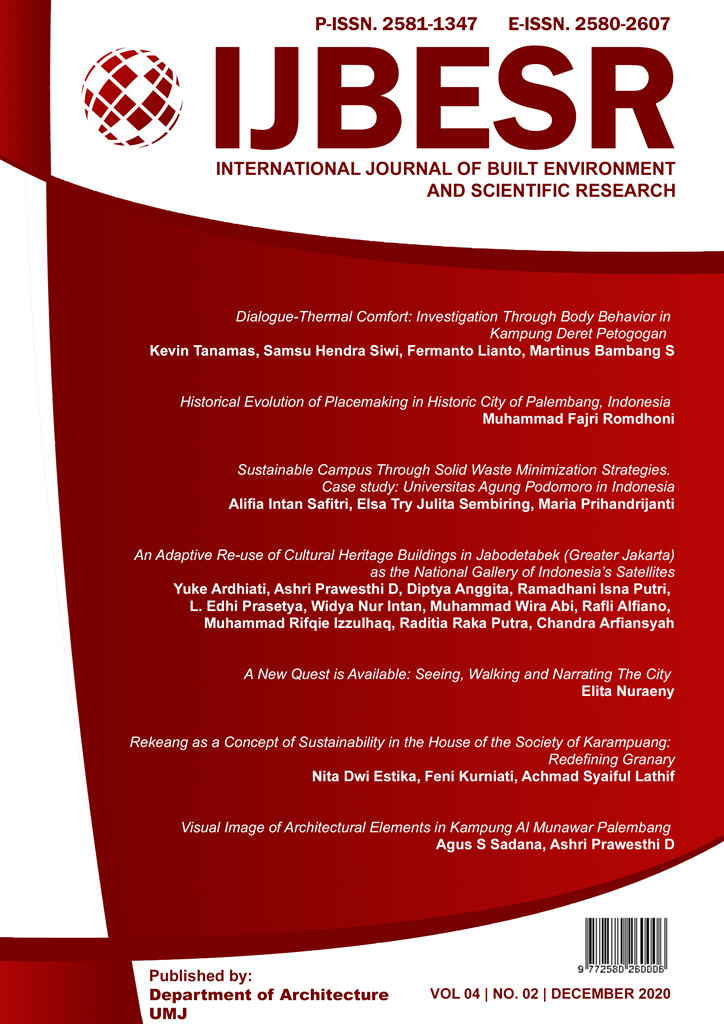Dialogue-Thermal Comfort: Investigation Through Body Behavior in Kampung Deret Petogogan
DOI:
https://doi.org/10.24853/ijbesr.4.2.73-84Keywords:
Body Behavior, Thermal Comfort, Activity, Kampung Deret PetogoganAbstract
This paper explores the relationship between thermal comfort with body behavior. Thermal comfort which is usually measured using a thermo hygrometer, but in this paper the author will more focus on analyzing the body behavior of the occupants in identifying spaces that are comfortably and thermal discomfort. The classification of spaces, elements, and occupants’ activities that will affects the level of thermal comfort here. This study took three sample houses as a representation in the Kampung Deret Petogogan, using in-depth interviews, observing the body behavior of the occupants and the researches. The purpose of this research is to get an answer from the use of RISHA House in the Kampung Deret Petogogan which is a government program that can provide thermal comfort for the occupants. The results of this research are expected to be a guideline for government to developing RISHA House in the future.References
Dear, D., Richard, Brager, G.S. 1998. Developing and Adaptive Model of Thermal Comfort and Preference. ASHRAE Transactions, Vol 104 (1), pp. 145-167.
Biner, P.M., Butler, D.L., Lovegrove, T.E., Burns, R.L. 1993. Windowless in the workplace: A reexamination of the compensation hypothesis. Environment and Behavior, 25, (2), 205-227.
Feustel, H., Stetiu, C. 1995. Hydronic radiant cooling-preliminary assessment, Energy and Buildings 22(3) (1995) 193-205.
Allan & Pease, B. 2004. The Definitive Book of Body Language. Australia; Pease International.
Smedley, C. 2004. Gesture: Your Body Speaks. USA; Toastmasters International.
Tohoku University. 2013. Annex 53 Total energy use in buildings. Sendai, Japan: International Energy Agency.
Bell, P.A., Greene, T.C., Fisher, J.D., Baum, A. 1996, “Environmental Psychology” Fourth Edition, Holt, Rinehart, and Winston, Inc., USA.
Atkinson, R.L. 1996. Hilgard’s Introduction to Psychology, Twelfth Edition, Harcourt Brace & Company, USA.
Watson, A. 2010. Know and Learn: Body Language.
Jon, L. 1987. Creating Architectural Theory: The Role of the Behavioral Sciences in Environmental Design, Van Nostrand Reinhold Company, USA.
Sommer, R. 1974. Looking back at personal space. In J. Lang (Ed), Designing for Human Behavior. Architecture and the Behavioral Sciences (pp. 202-209). Stroudsburg, Pa.: Dowden, Hutchinson, and Ross.
Auliciems, A., & Szokolay, S. 2007. Thermal Comfort. 2nd Revised Edition, Brisbane, PLEA: Passive and Low Energy Architecture International in association with Department of Architecture, The University of Queensland.
Chappells, H & Shove, E. 2007. Debating the Future of Comfort: Environmental Sustainability, Energy Consumption, and The Indoor Environment. Building Research & Information, 32-40.
Cole, Robinson, J., Brown, Z., O’seha, M. 2008. Re-contextualizing The Notion of Comfort. Building Research & Information, 36, (4), 323 - 336.
Leaman & Bordass. 2010. Productivity in Buildings: The ‘Killer’ Variables. Building Research and Information. 1 (1): 4-19.
Lenzuni, P., Freda, D., Gaudio, D.M. 2009.Classification of Thermal Environments for Comfort Assessment. Annals of Occupational Hygiene. 53 (4): 325–32.
Wyon, D.P., Andersen, I., Lundqvist, G.R. 2009. Spontaneous magnitude estimation of thermal discomfort during changes in the ambient temperature. Journal of Hygiene. 70 (2): 203–21.
Yudistira, F., & Yatmo, Y.A., Atmodiwirjo, P. 2019. From Rigidity to Ephemerality: Architecture as a Socio-spatial Assemblage of Heterogeneous Components. A/Z ITU Journal of Faculty of Architecture, Volume 16(3), pp. 115-129.
Atmodiwirjo, P., & Yatmo, Y. 2019. Interiority in Everyday Space: A Dialogue between Materiality and Occupation. Interiority, 2(1), 1-4.
Nikolopoulou & Steemers. 2003. Thermal Comfort and Psychological Adaptation as a Guide for Designing Urban Spaces. Energy and Buildings 35 (1): 95-101.
Steven, J., Emmerich, W., Dols, S., James, W., Axley. 2001. Natural Ventilation Review and Plan for Design and Analysis Tools. National Institute of Standards and Technology. NISTIR 6781.
Jindong, W. 2015. Thermal Comfort and Occupant Behavior in Office Buildings in South-East China. Ph.D. Thesis, University of Nottingham.
Stafford, L. 2019. Contested Interiority: Sense of Outsideness/Insideness Conveyed through Everyday Interactions with University Campus Doors. Interiority, 2(1), 25-41.
Putra, A. P. D & Lukito, Y. N. 2018. Architect and Emphaty: The Importance of Human Experience in Architectural Design. International Journal of Built Environment and Scientific Research, Vol. 02, No. 01, 47-54.
Ghany, A.M. 2013. Human Thermal Comfort and Heat Stress in an Outdoor Urban Arid Environment: A Case Study. Hindawi. Advances in Meteorology, Vol 2013, ID 693541.
Adaji, Michael, Watkins, Richard, Adler, Gerald. 2015. An Investigation into Thermal Comfort in Residential Buildings in the Hot-Humid Climate of Sub-Saharan Africa: A Field Study in Abuja-Nigeria. IN: Proceedings of 31st International PLEA Conference, Passive Low Energy Architecture: Architecture in (R)Evolution.
Finlay, L. 2011. Phenomenology for therapists: Research the lived world. Oxford: John Wiley & Sons.
Ogulata, T. 2007. The Effect of Thermal Insulation of Clothing on Human Thermal Comfort. Cukurova University.
ISO Standard (International Standard Organization). 2005. Ergonomics of the thermal environment - Analytical determination and interpretation of thermal comfort using calculation of the PMV and PPD Indices and local thermal comfort criteria. ISO 7730:2005 (E).







